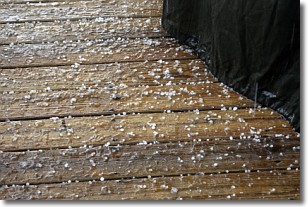Weather Alert in Texas
Flood Advisory issued April 28 at 8:36AM CDT until May 1 at 7:00AM CDT by NWS Norman OK
AREAS AFFECTED: Wichita, TX; Wilbarger, TX
DESCRIPTION: ...The Flood Advisory is extended for the following rivers in Texas... Beaver Creek near Electra affecting Wichita and Wilbarger Counties. * WHAT...Flooding caused by excessive rainfall continues. * WHERE...Beaver Creek near Electra. * WHEN...Until Thursday morning. * IMPACTS...At 23.0 feet, Shallow and short duration flooding of lowlands along and near the creek may occur in southern Wilbarger County and southwestern Wichita County. * ADDITIONAL DETAILS... - At 8:00 AM CDT Monday the stage was 20.0 feet. - Bankfull stage is 24.0 feet. - Forecast...The Beaver Creek is expected to rise to a crest of 23.4 feet early Wednesday morning. - Action stage is 22.0 feet. - Flood stage is 24.0 feet. - http://www.weather.gov/safety/flood
INSTRUCTION: If you encounter a flooded roadway, turn around and find an alternative route. Additional information is available at www.weather.gov.
Want more detail? Get the Complete 7 Day and Night Detailed Forecast!
Current U.S. National Radar--Current
The Current National Weather Radar is shown below with a UTC Time (subtract 5 hours from UTC to get Eastern Time).

National Weather Forecast--Current
The Current National Weather Forecast and National Weather Map are shown below.

National Weather Forecast for Tomorrow
Tomorrow National Weather Forecast and Tomorrow National Weather Map are show below.

North America Water Vapor (Moisture)
This map shows recent moisture content over North America. Bright and colored areas show high moisture (ie, clouds); brown indicates very little moisture present; black indicates no moisture.

Weather Topic: What is Rain?
Home - Education - Precipitation - Rain
 Next Topic: Shelf Clouds
Next Topic: Shelf Clouds
Precipitation in the form of water droplets is called rain.
Rain generally has a tendency to fall with less intensity over a greater period
of time, and when rainfall is more severe it is usually less sustained.
Rain is the most common form of precipitation and happens with greater frequency
depending on the season and regional influences. Cities have been shown to have
an observable effect on rainfall, due to an effect called the urban heat island.
Compared to upwind, monthly rainfall between twenty and forty miles downwind of
cities is 30% greater.
Next Topic: Shelf Clouds
Weather Topic: What is Sleet?
Home - Education - Precipitation - Sleet
 Next Topic: Snow
Next Topic: Snow
Sleet is a form of precipitation in which small ice pellets are the primary
components. These ice pellets are smaller and more translucent than hailstones,
and harder than graupel. Sleet is caused by specific atmospheric conditions and
therefore typically doesn't last for extended periods of time.
The condition which leads to sleet formation requires a warmer body of air to be
wedged in between two sub-freezing bodies of air. When snow falls through a warmer
layer of air it melts, and as it falls through the next sub-freezing body of air
it freezes again, forming ice pellets known as sleet. In some cases, water
droplets don't have time to freeze before reaching the surface and the result is
freezing rain.
Next Topic: Snow
Current conditions powered by WeatherAPI.com




